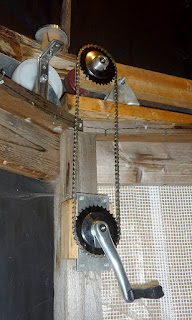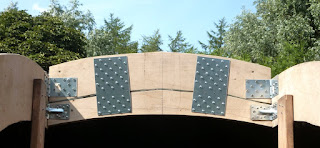*
Friday 27th Heavy overcast, wet and windy. I have the shutters arched on the ground to shed as much rain as possible. They usually lie on their sides but that risks the plywood ribs becoming saturated.
A check, after yet more rain, showed several of the upper bolts on the dome segments were leaking. Not badly, just a few droplets running down. I certainly don't want rainwater dripping onto the instruments below after installation.
Perhaps I can reach these bolts through the open slit. Without removing the tarpaulin. They are, at least, the most accessible. Though not actually covered by the tarpaulin. This job can wait for better weather. Or, not. As it kept showering I decided to go ahead and worked from a short ladder. 20 segment fixing bolts now have rubber washers. All the washers I had. I shall buy more when I can.
Regarding the dome's base ring fixing. I am now thinking I should fit bolts and brackets to ensure maximum resistance to lifting. I intend to fibre-glass over the top of the rings. Though this assumes I maintain perfection in level. Not an easy task with such a very large, and relatively thin, plywood ring. Which is only propped on the dome reinforcement rib on its outer edge. Until fully bonded in. The stakes on the inside are little more than a guide to level. Also to support the rings for mock-ups.
The loads on the base ring are mostly upwards. Because it rests on the rotation rollers. Assuming ~500kg for the finished dome the upwards force will be spread over a comparatively small area of dome wall. Relying entirely on polyester, GRP adhesion over a strip [say] 10cm wide x 10m may be too much like wishful thinking.
Mechanical fixing would offer greater piece of mind. The dome is thickest down near the skirt. So bolts would enjoy considerable lateral resistance even without the clamping forces from the bolts. They would be very unlikely to tear out. Another ring of bolt heads around the dome skirt would hardly detract from its appearance. Probably just adding to the "Steam Punk" effect like more rows of rivets. I ought to look for heavier brackets than those I used on the shutters.
One problem with brackets above the base ring is that they would be fibre-glassed in. Making removal all but impossible. If the base ring should degrade over time then replacement becomes a real chore. I can't invert the brackets without cutting away the dome's vital base ring reinforcing rib. Beside, the brackets would lie on the path of the rollers. As would any fixing bolts through the ring itself.
The next, most obvious alternative, is to have the base ring
under the dome reinforcing rib. The rib would provide enormous resistance to lifting. If only at the outer edge. I would still fibre-glass the ring to carry the dome's own rib stiffness well out over the plywood ring. Bracing the inner edges of the ring would require bolted stays rather than simple L-brackets. There is still the risk of roller obstruction from fixings.
In an earlier post I considered sandwiching the dome's circumferential D-rib with plywood rings. One ring above and one below. With filler rings for increased stiffness. The dome's skirt reinforcing rib is not precisely placed. So there would be some variation in sandwich filler thickness and the exact location of the base ring relative to the rib.
Which suggests oversized filler material to avoid variations in ring level. The rings then being mounted slightly independently of the dome's reinforcing rib but accurately level with the dome skirt This arrangement would arguably enjoy the best cosmetic appearance. The base ring would be very deep and far stiffer than the other options. 65mm wide softwood could be sandwiched between the pairs of rings. It need not even be curved. But could be fixed with Csk. wood screws to avoid obstructing the roller track.
Having the base ring raised above the dome reinforcing rib provides 125mm more coverage of the rotation rollers. 60cm form the skirt to the rib. Which is 65mm high outside any radius. This extra depth means reducing the required height of the weather-proofing, add-on skirt.
I do not want another rubber skirt flapping in the wind! Even the thickest pond liner is all too flexible when hanging freely under its own, considerable weight.
Alternative, add-on skirts could easily detract from the appearance of the mounted dome. I have no obvious candidates. Other than thin, painted, Baltic Birch plywood. Which would extend vertically downwards from the inside of the dome skirt and over the top of the building. To throw the weather outside the building's footprint.
I plan to have another sturdy, plywood ring on top of the building. Which will provide the necessary circular form. To close any gaps between the multi-sided building and the weatherproofing skirt. Since absolute precision of concentricity is impossible I may need a circumferential, draught excluding brush. Of the type fitted to the bottoms of doors. The self adhesive types are available in 5m lengths.
As the showers continued through the afternoon I propped up some mock-ups of possible base ring configurations. [See images above.]
*



















































